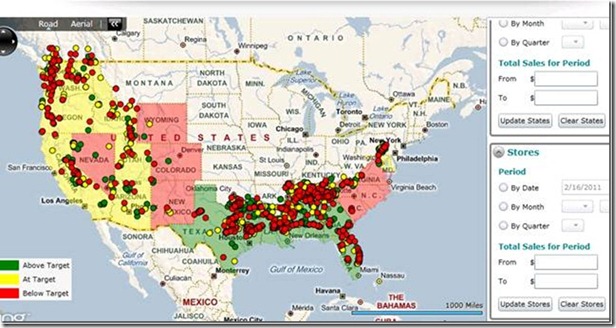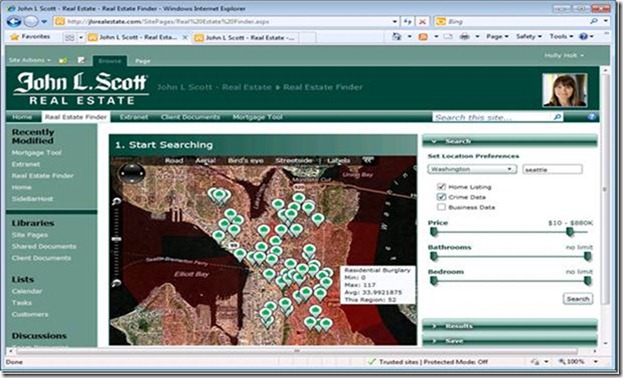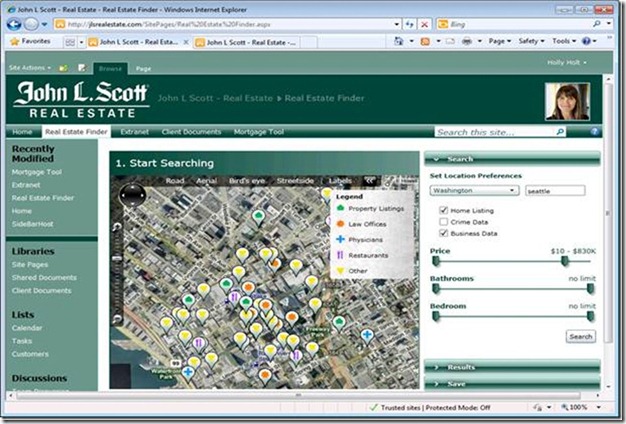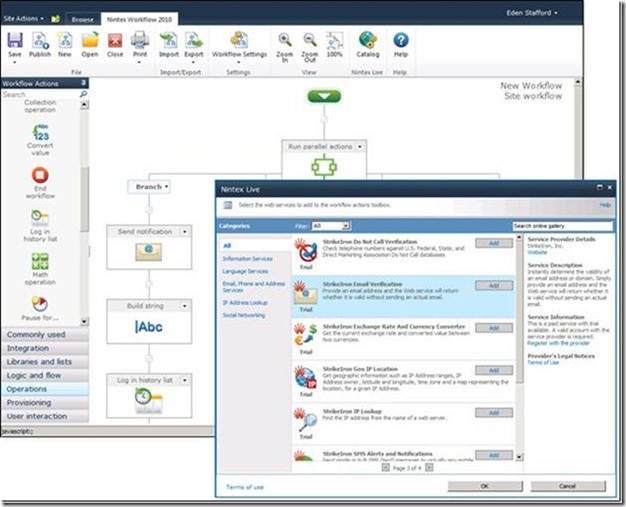SharePoint and Windows Azure: Why They’re Better Together?
Last Friday, we presented an Academy Live (AL) session that discussed, at the introductory level, how SharePoint and Windows Azure Platform come together. On the call were myself (Steve Fox), Mike Fitzmaurice (VP, Technology at Nintex) and Donovan Follette (Sr. Technical Evangelist at MSFT).
In the session, we provided an overview of some observations of the IT market with a quick review of Windows Azure and SharePoint. We also discussed how these two technologies come together; namely, reach, resource and reusability.
Reach - When you see the cloud as a place to deploy applications, your reach naturally widens. For example, deploying your services and applications in Windows Azure, they are available to many SharePoint clients. By leveraging the Windows Azure Marketplace DataMarket or deploying your own custom WCF services or ASP.NET applications, you not only are able to better monetize on optimization, but the opportunity to take advantage of your Windows Azure applications and services can be extended to your customers as well. This is a tremendous opportunity for you because it means you can write once, sell many times, and let Windows Azure worry about scale.
Resource – Storage costs can be expensive and the need to quickly access, store and archive digital assets (documents, media, etc.) is only going to increase over time. While solutions such as RBS are central to SharePoint, having additional ways to leverage cost-effective storage mechanisms across different scenarios is important—not only for costs but for IT optimization, but for greater efficiencies resulting from improved collaboration as well. By leveraging remote file storage, such as Windows Azure BLOB storage and data management in SQL Azure, you can reduce resource costs, and at the same time providing greater value to customers with effective solutions.
Reusability – The cloud is about reusing your existing skills and your existing code; it’s not all about reinvention and multiple code bases. With .NET, you are able to reuse already-built .NET applications in the cloud, or reuse your existing skills to build new ones. Further, the cloud provides the opportunity for service layers that enable cross-device (e.g. phone, web and PC) connectivity and cross-platform integration.
You can take a look at the slides by clicking through the PPT Web App below:
We also walked through a number of demos. The first was showing some basic integration with Windows Azure. Specifically, I showed an external list and described how you can very easily create an integration using SharePoint lists with SQL Azure using SharePoint Designer 2010. Second, I showed a new demo (Contoso Oil and Gas) that integrates SQL Azure, WCF services deployed to Windows Azure, Bing, and Silverlight. The figure below shows the integrated application, which provides a heat-map and custom pushpins for store sales in the domestic US. All of the data comes from the cloud.
Heat Map of Contoso Oil and Gas Sales using SQL Azure Data
Donovan then walked through a John L Scott branded real estate demo, which uses the Windows Azure Marketplace DataMarket (or what you might know as “Dallas”). This is a great demo that showcases a number of technologies such as Photosynth, Bing, Silverlight, SharePoint external lists, content types, and so on to walk through a great integration scenario. You can see from the figure below the loading of crime data from Dallas. The first figure shows an overlay of crime data onto the Bing maps, and the second shows business data. The goal is to provide you with a cloud-based set of data to help improve decision-making around finding the right property for a customer.
Crime Data from Windows Azure Marketplace to provide additional context for Seattle regions
Business Data from Windows Azure Marketplace to show specific businesses and restaurants in Seattle region
Mike Fitzmaurice then walked through a great partner demo, showcasing how Nintex is taking a bet on Windows Azure. He walked through the creation of a Nintex Live workflow that makes it easy to add cloud-based workflow actions and activities to your business process—screenshot below. One of the core scenarios he walked through was a Bing service deployed in Windows Azure (integrated with SharePoint through workflow) that enables you to check flight status so calendar appointments can be rescheduled. Very cool stuff! You can check out the Nintex Site and click on Products for more information.
Adding a new, cloud-based workflow activity using Nintex Live
We also announced v1 of a Developer Primer that shows you how to build integrated solutions bridging SharePoint and Windows Azure. For follow-up information such as the slides, Academy Live recording, link to the developer primer, etc., check out the links to follow.
- Get Started with a Trial Windows Azure Account. Get your trial Windows Azure license/account to get started developing with Windows Azure and SharePoint: https://www.microsoft.com/windowsazure/free-trial/sharepoint-integration/.
- Check out the new Point 8020 Case Study. We just published the new Point 8020 SharePoint and Windows Azure Case Study: https://www.microsoft.com/casestudies/Case_Study_Detail.aspx?CaseStudyID=4000009235. We want to publish more of these, so please reach out to me via my blog if your company is engaging in SharePoint and Windows Azure integration.
- Get Started Developing. Download the Windows Azure and SharePoint Developer Primer: https://www.microsoft.com/downloads/en/details.aspx?FamilyID=6d2dc556-650a-484f-8f52-f641967b42ea&displaylang=en.
Also note the great developer resources for both SharePoint and Windows Azure development on C9/MSDN:
- SharePoint Developer Training Kit: https://channel9.msdn.com/Learn/Courses/SharePoint2010Developer
- Windows Azure Developer Training Kit: https://msdn.microsoft.com/en-us/wazplatformtrainingcourse.aspx
You can also check out the recording and associated collateral from the above talk at this link:
- If you’re a Microsoft partner, you can access the recording here.
- You can also access the recording here.
We’ll have more information for you on this effort in the future, including revs of the developer kits, more sample code, MS Press book, more partner case studies, and more! Please stay tuned for more, at this website.
Steve



